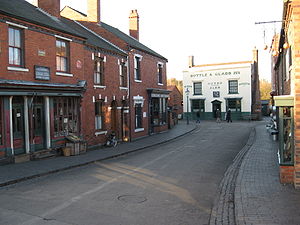Template:FP-Black Country Living Museum: Difference between revisions
Jump to navigation
Jump to search
Created page with "{{#switch:{{{1}}} |pic=Blackcountrystreet.jpg |cap=A street in the Black Country Living History Museum, Worcestershire |text='''The Black Country Living Museum''' is an open-a..." |
No edit summary |
||
| Line 2: | Line 2: | ||
|pic=Blackcountrystreet.jpg | |pic=Blackcountrystreet.jpg | ||
|cap=A street in the Black Country Living History Museum, Worcestershire | |cap=A street in the Black Country Living History Museum, Worcestershire | ||
|text='''The Black Country Living Museum''' is an open-air museum of rebuilt historic buildings in Dudley in [[Worcestershire]]. It | |text='''The Black Country Living Museum''' is an open-air museum of rebuilt historic buildings in Dudley in [[Worcestershire]]. It covers twenty-six acres of former industrial land in the centre of the Black Country, ten miles west of Birmingham. It encompasses a former railway goods yard, disused lime kilns, a canal arm and former coal pits. | ||
The Museum has since added over fifty shops, houses and other industrial buildings relocated from around the Black Country, where demonstrators portray life spanning three hundred years of history, with a focus on 1850-1950.}}<noinclude>{{FP data}} | The Museum has since added over fifty shops, houses and other industrial buildings relocated from around the Black Country, where demonstrators portray life spanning three hundred years of history, with a focus on 1850-1950.}}<noinclude>{{FP data}} | ||
Latest revision as of 21:09, 7 September 2018
 |
Black Country Living MuseumThe Black Country Living Museum is an open-air museum of rebuilt historic buildings in Dudley in Worcestershire. It covers twenty-six acres of former industrial land in the centre of the Black Country, ten miles west of Birmingham. It encompasses a former railway goods yard, disused lime kilns, a canal arm and former coal pits. The Museum has since added over fifty shops, houses and other industrial buildings relocated from around the Black Country, where demonstrators portray life spanning three hundred years of history, with a focus on 1850-1950. (Read more) |